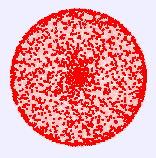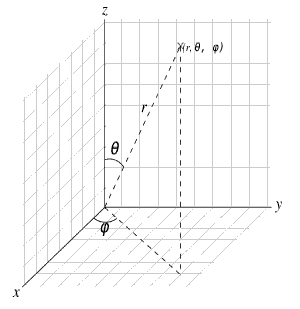

Points picked using a uniform distribution of angles will be bunched near the poles. What causes the bunching near the edge?
The Uniform Spherical Distribution model shows how to pick a random point on the surface of a sphere. It is incorrect to pick points using a uniform random distribution of zenith θ and azimuth φ angles because the area element dΩ is a function of θ.

Points picked using a uniform distribution of angles will be bunched near the poles because all area elements receive approximately equal numbers of random points but the area element shrinks as θ decreases.
To obtain a uniform distribution of points, chose random numbers u and v on [0,1) and compute a weighted distribution of angles using:

Note the 3D limb effect that produces an apparent bunching near the edge of the sphere. This bunching is an optical illusion produced by the projection of a 3D object onto a 2D view. Use the mouse to rotate the 3D view to observe the real (physical) bunching that occurs with a uniform random distribution of angles.
Create a model that shows a uniform distribution of points within a spherical volume.
The Uniform Spherical Distribution Model was created by Wolfgang Christian using the Easy Java Simulations (EJS) version 4.1 authoring and modeling tool.
You can examine and modify a compiled EJS model if you run the model (double click on the model's jar file), right-click within a plot, and select "Open Ejs Model" from the pop-up menu. You must, of course, have EJS installed on your computer. Information about Ejs is available at: <http://www.um.es/fem/Ejs/> and in the OSP comPADRE collection <http://www.compadre.org/OSP/>.

Spherical polar coordinates. φ is the azimuth angle and θ is the zenith or co-latitude angle.
The spherical polar coordinate system specifies a point (location) using the radial distance from a fixed origin, the zenith angle from the positive z-axis to the point, and the azimuth angle from positive x-axis to the projection of the point in the xy-plane. The notation convention for spherical polar coordinates varies between disciplines and authors. This model uses the standard physics convention θ and φ for the zenith and azimuth, respectively.